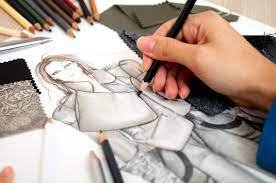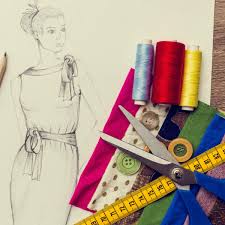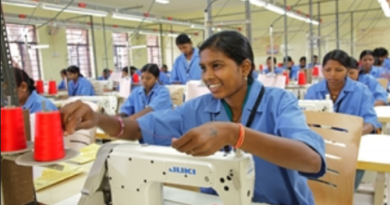Free Self Employed Tailor Course(1year Diploma)
Self Employed Tailor Course CLICK HERE
Self Employed Tailor is a role of a self employed professional tailor whocan sew and repair garments , made ups and homefurnishing articles and manage livelihood out of it.

Brief Job Description:– Self Employed Tailor is a skilled tailor versed with making customized Indian dresses. The job thus involves taking measurement, cutting fabric as per measurement and sewing with the help of ordinary sewing machines . The personalso does alteration works of stitched dress materials to correct and fit as per customer requirements.
Personal Attributes:- The tailor should havegood eyesight, eye-hand legcoordination, motor skills and clear vision and free from colour vision. The person should have good interpersonal skills, good listener and business acumen Self Employed Tailor Course

Identifying dress form, correct handling of measuring equipment, taking measurement correctly, basics of drafting and tools required and fabric cutting technique and factors involved in cutting fabrics Self Employed Tailor Course:- PC1. Take body measurement of the customer or the product
PC2. Select the appropriate tools & materials for drafting
PC3. Mark the measurements of a garment on a piece of paper with the help of the tools and make the standard patterns for reference
PC4. Cut the paper pattern as per the measurement
PC5. Place the cut components of paper for cutting the cloth
PC6. Select the appropriate tools & materials for cutting
PC7. Measure the length and width of the material/fabric before starting to cut
PC8. Ensure there are no defects on the material Self Employed Tailor Course.
PC9. Lay the fabric on the table in accordance with fabric grain line, designs, checks or plaids, etc.
PC10. Cut the various garment components with precision
PC11. Avoid fabric/material wastage while cutting
PC12. Organise cut components in a suitable bundle tied together
Sewing components into full products (dress and/or common household items of textiles) Self Employed Tailor Course:-

PC1. Set machines according to manufacturers’ instructions and sewing requirements
PC2. Set machine controls for the materials being stitched
PC3. Perform a test run to ensure machine is operating correctly
PC4. Join cut components by stitching
PC5. Carry out hand sewing (kaj making, button fixing, hemming, or basic embroidery etc.)
PC6. Make a final cost sheet Self Employed Tailor Course.

Final checking after stitching, identify alteration needs and corrections for fittings Self Employed Tailor Course:-

PC1. Check fitting of the dress materials onto the customers
PC2. Record required alteration needs and instructions on tags or labels and attach them to garments
PC3. Carry out alterations as per records
Maintenance of health, safety and security in the workplace:-
PC1. Keep vigilance for potential risks and threats associated with shop and its equipments like fire, theft, etc.
PC2. Handle tools and equipmentslike sewing machines, scissors, shears, etc. safely and securely
PC3. Keep alert in the shop and during work processes to avoid potential risks and threats
PC4. Install basic safety signage in the shop for customer knowledge as well
PC5. Undertake first-aid, fire-fighting and emergency response training Self Employed Tailor Course.
Maintain the workarea, tools and machines Self Employed Tailor Course:-
To be competent, the user/individual on the job must be able to:
PC1. Handle materials, machinery, equipment and tools safely and correctly
PC2. Use correct lifting and handling procedures
PC3. Use materials to minimize waste
PC4. Maintain a clean and hazard free working area
PC5. Maintain tools and equipment
PC6. Carry out running maintenance within agreed schedules
PC7. Carry out maintenance and/or cleaning within one’s responsibility
PC8. Report unsafe equipment and other dangerous occurrences
PC9. Ensure that the correct machine guards are in place
PC10.Work in a comfortable position with the correct posture
PC11.Use cleaning equipment and methods appropriate for the work to be carried out
PC12.Dispose of waste safely in the designated location
PC13. Store cleaning equipment safely after use Self Employed Tailor Course.
PC14.Carry out cleaning according to schedules and limits of responsibility

Comply with industry, and organizational requirements Self Employed Tailor Course:-

To be competent, the user/individual on the job must be able to:
PC1. Carry out work functions in accordance with legislation and regulations, organizational guidelines and procedures
PC2. Seek and obtain clarifications on policies and procedures, from your supervisor or other authorized personnel
PC3. Apply and follow these policies and procedures within your work practices
PC4. Provide support to your supervisor and team members in enforcing these considerations
PC5. Identify and report any possible deviation to these requirements
Guidelines for Assessment:-
- Criteria for assessment for each Qualification Pack will be created by the Sector Skill Council. Each Performance Criteria (PC) will be assigned marks proportional to its importance in NOS. SSC will also lay down proportion of marks for Theory and Skills Practical for each
PC 2. The assessment for the theory part will be based on knowledge bank of questions approved by the
SSC 3. Individual assessment agencies will create unique question papers for theory part for each candidate at each examination/training center (as per assessment criteria below)
4. Individual assessment agencies will create unique evaluations for skill practical for every student at each examination/training center based on this criteria
5. To pass the Qualification Pack, every trainee should score a minimum of 70% aggregate in a 6. In case of successfully passing only certain number of NOS’s, the trainee is eligible to take subsequent assessment on the balance NOS’s to pass the Qualification Pack

(Drafting and cutting the fabric):-
PC1. Take body measurement of the customer or the product
PC2. Select the appropriate tools and materials for drafting
PC3. Mark the measurements of a garment on a piece of paper with the help of the tools and make the standard patterns for reference
PC4. Cut the paper pattern as per the measurement Self Employed Tailor Course.
PC5. Place the cut components of paper for cutting the cloth
PC6. Select the appropriate tools and materials for cutting
PC7. Measure the length and width of the material/fabric before starting to cut
PC8. Ensure there are no defects on the material
PC9. Lay the fabric on the table in accordance with fabric grain line, designs, checks or plaids, etc
PC10. Cut the various garment components with precision
PC11. Avoid fabric/material wastage while cutting
PC12. Organise cut components in a suitable bundle tied together
Carry out the process of sewing for dress materials and common household items of textiles):-
PC2. Set machine controls for the materials being stitched
PC3. Perform a test run to ensure machine is operating correctly
PC4. Join cut components by stitching
PC5. Carry out hand sewing (kaj making, button fixing, hemming, basic embroidery etc.)
C6. Make a final cost sheet
Carry out inspections and alterations to adjust corrections for fittings:-
PC1. Check fitting of the dress materials onto the customers Self Employed Tailor Course.
PC2. Record required alteration needs and instructions on tags or labels and attach them to garments
PC3. Carry out alterations as per records
(Maintain health, safety and security in the tailoring shop):-
PC1. Keep vigilance for potential risks and threats associated with shop and its equipments like fire, theft, etc.
PC2. Handle tools and equipments like sewing machines, scissors, shears, etc. safely and securely
PC3. Keep alert in the shop and during work processes to avoid potential risks and threats
PC4. Install basic safety signage in the shop for customer knowledge as wel
PC5. Undertake first-aid, firefighting and emergency response training
(Maintain workarea, tools and machines):-
PC1. Handle materials, machinery, equipment and tools safely and correctly
PC2. Use correct lifting and handling procedures
PC3. Use materials to minimize waste
PC4. Maintain a clean and hazard free working area Self Employed Tailor Course.
PC5. Maintain tools and equipments
PC6. Carry out running maintenance within agreed schedules
PC7. Carry out maintenance and/or cleaning within one’s responsibility
PC8. Report unsafe equipment and other dangerous occurrences
PC9. Ensure that the correct machine guards are in place
PC10. Work in a comfortable position with the correct posture
PC11. Use cleaning equipment and methods appropriate for the work to be carried out
PC12. Dispose of waste safely in the designated location
PC13. Store cleaning equipment safely after use
PC14. Carry out cleaning according to schedules and limits of responsibility
(Comply with industry, regulatory and organizational requirements):-
PC1. Carry out work functions in accordance with legislation and regulations, organizational guidelines and procedures
PC2. Seek and obtain clarifications on policies and procedures, from your supervisor or other authorized personnel
PC3. Apply and follow these policies and procedures within your work practices
PC4. Provide support to your supervisor and team members in enforcing these considerations
PC5. Identify and report any possible deviation to these requirements Self Employed Tailor Course.
Organizational Context:-
The user/individual on the job needs to know and understand:
KA1. Personal hygiene and duty of care
KA2. Safe working practices and organizational procedures
KA3. Limits of your own responsibility
KA4. Ways of resolving with problems within the work area
KA5. The production process and the specific work activities that relate to the whole process KA6. The importance of effective communication with colleagues
KA7. The lines of communication, authority and reporting procedures
KA8. The organization’s rules, codes and guidelines (including timekeeping)
KA9. The company’s quality standards
KA10. The importance of complying with written instructions Self Employed Tailor Course.
KA11. Equipment operating procedures / manufacturer’s instructions
Technical knowledge:-
The user/individual on the job needs to know and understand:
KB1. Work instructions and specifications and interpret them accurately
KB2. Method to make use of the information detailed in specifications and instructions
KB3. Relation between work role and the overall manufacturing process
KB4. The importance of taking action when problems are identified
KB5. Different ways of minimizing waste
KB6. The importance of running maintenance and regular cleaning
KB7. Effects of contamination on products i.e. Machine oil, dirt
KB8. Common faults with equipment and the method to rectify
KB9. Maintenance procedures
KB10. Hazards likely to be encountered when conducting routine maintenance
KB11. Different types of cleaning equipment and substances and their use
KB12. Safe working practices for cleaning and the method of carrying them out
Core Skills/ Generic Skills:-
The user/individual on the job needs to know and understand how to:
SA1. Write and document appropriate technical forms, job cards, inspection sheets as required format of the company
Reading Skills:- The user/individual on the job needs to know and understand how to:
SA2. Read and comprehend basic English to read and interpret indicators in the machine and operating manuals, job cards, visual cards
SA3. Read and understand manuals, health and safety instructions, memos, reports, job cards, etc
Oral Communication (Listening and Speaking skills):- The user/individual on the job needs to know and understand how to:
SA4. Speak and communicate effectively to peers and supervisors
SA5. Give clear instructions to co-workers, subordinates, others
SA6. Use correct technical term while interacting with supervisor
Professional Skills:- The user/individual on the job needs to know and understand how to:
SB1. Take appropriate decisions regarding to responsibilities
SB2. Assess for any damage/faulty component in the concerned machinery and take action accordingly
SB3. Evaluate the decision and conduct basic trouble shooting
Plan and Organize:-
The user/individual on the job needs to know and understand how to:
SB4. Plan and manage work routine based on company procedure
SB5. Work with supervisors/team mates to carry out work related tasks
SB6. Plan for cleaning and lubricating the concerned machinery daily
SB7. Plan for cleaning the concerned tools and workplace daily before and after operations
Customer Centricity:-
The user/individual on the job needs to know and understand how to:
SB8. Ensure and follow organizational procedures pertaining to health and safety are followed
Problem Solving:-
The user/individual on the job needs to know and understand how to:
SB7. Solve operational role related issues
Analytical Thinking:-
The user/individual on the job needs to know and understand how to:
SB9. Diagnose common problems in the machine based on visual inspection, sound, temperature, etc.
Critical Thinking:-
The user/individual on the job needs to know and understand how to:
SB10. Analyze, evaluate and apply the information gathered from observation, experience, reasoning or communication to act efficiently
Drafting and cutting the fabric:-
Take body measurement of the
· customer or the product Select the appropriate tools
· & materials for drafting Mark the measurements of a garment
· on a piece of paper with the help of the tools and make the standard patterns for reference Cut the paper pattern as per the
· measurement Place the cut components of paper for
· cutting the cloth Select the appropriate tools
· & materials for cutting Measure the length and width of the
· material/fabric before starting to cut Ensure there are no defects on the
· material Lay the fabric on the table in
· accordance with fabric grain line, designs, checks or plaids, etc. Cut the various garment components
· with precision Avoid fabric/material wastage while
· cutting Organise cut components in a suitable
· bundle tied together
Carry out the process of sewing for dress materials and common household items of textiles Theory Duration:-
Set machines according to
· manufacturers’ instructions and sewing requirements Set machine controls for the materials
· being stitched Perform a test run to ensure machine is
· operating correctly Join cut components by stitching
· Carry out hand sewing (kaj making,
· button fixing, hemming, or basic embroidery etc.) Make a final cost sheet
Carry out inspections and alterations to adjust corrections for fittings:-
Identify methods of garment fitting
· Recognise common fitting errors and
· their solutions Check fitting of the dress materials onto
· the customers Record required alteration needs and
· instructions on tags or labels and attach them to garments Carry out alterations as per records
Comply with industry, regulatory and organizational requirements:-
Carry out work functions in accordance
· with legislation and regulations, organizational guidelines and procedures Seek and obtain clarifications on
· policies and procedures, from your supervisor or other authorized personnel Apply and follow these policies and
· procedures within your work practices Provide support to your supervisor and
· team members in enforcing these considerations Identify and report any possible deviation to these requirements Understand importance of being an
· entrepreneur Understand concepts of tailor shop
· economics like book keeping, inventory management Understand importance of
· documentation Identify various registers and
· documents required Complete documentation appropriately
Understand importance of effective
· communication Communicate effectively with others
· Identify and follow personal grooming
· and hygiene Follow organization procedures and
· maintain personal health and hygiene and avoid habits like ghutka, tobacco etc. Interact effectively in a group
· Manage time effectively
· Understand importance of resume and
· prepare your resume Prepare for interviews
Identify methods of first aid
· Undertake basic first aid,
· Undertake basic CPR
Personal Attributes:- The candidate should have aptitude for conducting training, pre /post work to ensure competent, employable candidates at the end of training. Strong communication skills, interpersonal skills, ability to work as team; diligent and is passionate for maintaining the quality in content and training delivery methodology. Candidate should have basic understanding of English language; however this should not be a restrictive criterion as long as the candidate is willing and open to learn. He/she must be able to speak, read and write in the local language.
Experience:-
Experience: The candidate should have a minimum of 3 years of professional and industrial experience. He should be able to communicate in English and local language. He should have knowledge of equipment, tools, material, Safety, Health & Hygiene.
1 The minimum required experience could be relaxed by the vigilance committee of AMHSSC, if the concerned candidate possesses qualification from premium institutes , like NID, NIFT etc.
(Drafting and cutting the fabric):-
PC1. Take body measurement of the customer or the product
PC2. Select the appropriate tools and materials for drafting
PC3. Mark the measurements of a garment on a piece of paper with the help of the tools and make the standard patterns for reference
PC4. Cut the paper pattern as per the measurement
PC5. Place the cut components of paper for cutting the cloth
PC6. Select the appropriate tools and materials for cutting
PC7. Measure the length and width of the material/fabric before starting to
PC8. Ensure there are no defects on the material
PC9. Lay the fabric on the table in accordance with fabric grain line, designs, checks or plaids, etc
PC10. Cut the various garment components with precision
PC11. Avoid fabric/material wastage while cutting
PC12. Organise cut components in a suitable bundle tied together
(Carry out the process of sewing for dress materials and common household items of textiles):-
PC1. Set machines according to manufacturers’ instructions and sewing requirements
PC2. Set machine controls for the materials being stitched
PC3. Perform a test run to ensure machine is operating correctly
PC4. Join cut components by stitching
PC5. Carry out hand sewing (kaj making, button fixing, hemming, basic embroidery etc.)
PC6. Make a final cost sheet
(Carry out inspections and alterations to adjust corrections for fittings):-
PC1. Check fitting of the dress materials onto the customers
PC2. Record required alteration needs and instructions on tags or labels and attach them to garments
PC3. Carry out alterations as per records
(Comply with industry, regulatory and organizational requirements):-
PC1. Carry out work functions in accordance with legislation and regulations, organizational guidelines and procedures
PC2. Seek and obtain clarifications on policies and procedures, from your supervisor or other authorized personnel
PC3. Apply and follow these policies and procedures within your work practices
PC4. Provide support to your supervisor and team members in enforcing these considerations
PC5. Identify and report any possible deviation to these requirements







